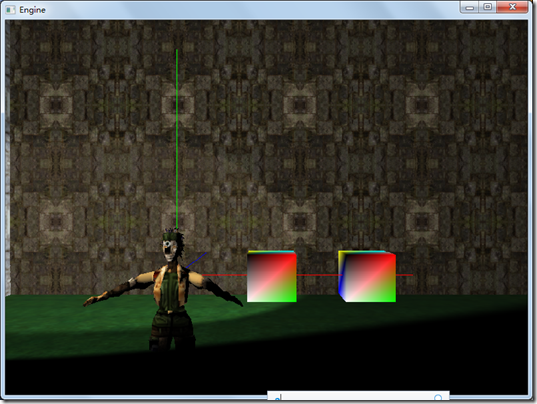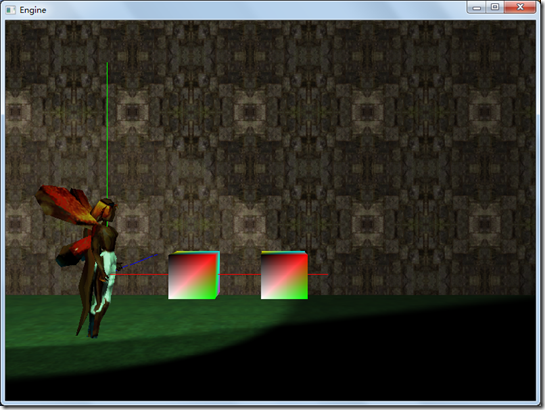在前面的教程中,我们都是通过在ModelClass中直接产生顶点和索引数据,简单的三角形,立方体等等还好说,毕竟比较简单,如何显示复杂的三维物体呢?特别是利用已有的3D文件,比如obj, 3ds, md2, x等格式的文件,这时,就要利用这些3D格式的解析器,本教程中,我们利用Open Asset Import Library库,来显示各种格式的3D文件(动画文件,暂时不考虑,只考虑静态的3D文件)。
Open Asset Import Library是一个开源的模型导入库,支持很多格式,它的下载和安装就不介绍了,下面我再myTutorialD3D11_35的基础上,加入使用Assimp库导入3D文件的代码。
主要就是增加了一个AssimpModelClass类,该类中顶点格式为:
{
D3DXVECTOR3 position;
D3DXVECTOR3 normal; //法向
D3DXVECTOR2 texture; //纹理坐标
D3DXVECTOR4 Kd; //材质漫反射系数
D3DXVECTOR4 Ks; //材质的高光系数
};
产生顶点和索引缓冲的函数为AssimpModelClass,我们通过该函数产生顶点缓冲和索引缓冲。
bool AssimpModelClass::LoadModel(ID3D11Device* device, std::string filename)
{
HRESULT result;
注意:首先我们会定义一个assimp导入器类,用该类读入模型文件,我们会做2趟循环,第一趟循环得到顶点和索引的数量,然后创建顶点和索引临时缓冲,用来保存顶点和索引数据,第二趟循环从模型文件中读取顶点和索引的数据,最后创建顶点和索引缓冲。
Assimp::Importer importer;
VertexType* vertices;
unsigned long* indices;
D3D11_BUFFER_DESC vertexBufferDesc, indexBufferDesc;
D3D11_SUBRESOURCE_DATA vertexData, indexData;
const aiScene* scene = importer.ReadFile(filename,aiProcessPreset_TargetRealtime_Quality);
if(!scene)
{
MessageBoxA(NULL, importer.GetErrorString(), "Error", MB_OK);
return false;
}
int m =0;
//第一趟扫描,得到顶点和索引计数
for(m=0; m<scene->mNumMeshes; ++m )
{
//第m个mesh
aiMesh* aiMesh = scene->mMeshes[m];
m_vertexCount += aiMesh->mNumVertices;
m_indexCount += aiMesh->mNumFaces*3;
}
// 创建顶点临时缓冲.
vertices = new VertexType[m_vertexCount];
if(!vertices)
{
return false;
}
// 创建索引临时缓冲.
indices = new unsigned long[m_indexCount];
if(!indices)
{
return false;
}
//临时的顶点和索引指针
int index1 = 0;
int index2 = 0;
int i = 0;
//第二趟循环,得到每个顶点和索引的值
for(m=0; m<scene->mNumMeshes; ++m )
{
//第m个mesh
aiMesh* aiMesh = scene->mMeshes[m];
if(!aiMesh->HasNormals() || !aiMesh->HasTextureCoords(0))
{
MessageBox(NULL, L"模型文件中没有纹理坐标或者法向信息", L"Error", MB_OK);
return false;
}
int vertexCount = aiMesh->mNumVertices;
for(i = 0;i < vertexCount;++i)
{
vertices[index1].position = D3DXVECTOR3(aiMesh->mVertices[i].x, aiMesh->mVertices[i].y, aiMesh->mVertices[i].z);
vertices[index1].normal = D3DXVECTOR3(aiMesh->mNormals[i].x, aiMesh->mNormals[i].y, aiMesh->mNormals[i].z);
vertices[index1].texture = D3DXVECTOR2(aiMesh->mTextureCoords[0][i].x, aiMesh->mTextureCoords[0][i].y);
vertices[index1].Kd = D3DXVECTOR4(1.0, 1.0, 1.0,1.0);
vertices[index1].Ks = D3DXVECTOR4(0.2, 0.2, 0.2,1.0);
index1++;
}
for (i = 0; i < aiMesh->mNumFaces;++i)
{
const aiFace& Face = aiMesh->mFaces[i];
//assert(Face.mNumIndices == 3);
indices[index2] = Face.mIndices[0];
index2++;
indices[index2] = Face.mIndices[1];
index2++;
indices[index2] = Face.mIndices[2];
index2++;
}
}
// 设置顶点缓冲描述
vertexBufferDesc.Usage = D3D11_USAGE_DEFAULT;
vertexBufferDesc.ByteWidth = sizeof(VertexType) * m_vertexCount;
vertexBufferDesc.BindFlags = D3D11_BIND_VERTEX_BUFFER;
vertexBufferDesc.CPUAccessFlags = 0;
vertexBufferDesc.MiscFlags = 0;
vertexBufferDesc.StructureByteStride = 0;
// 指向保存顶点数据的临时缓冲.
vertexData.pSysMem = vertices;
vertexData.SysMemPitch = 0;
vertexData.SysMemSlicePitch = 0;
// 创建顶点缓冲.
result = device->CreateBuffer(&vertexBufferDesc, &vertexData, &m_vertexBuffer);
if(FAILED(result))
{
HR(result);
return false;
}
// 设置索引缓冲描述.
indexBufferDesc.Usage = D3D11_USAGE_DEFAULT;
indexBufferDesc.ByteWidth = sizeof(unsigned long) * m_indexCount;
indexBufferDesc.BindFlags = D3D11_BIND_INDEX_BUFFER;
indexBufferDesc.CPUAccessFlags = 0;
indexBufferDesc.MiscFlags = 0;
indexBufferDesc.StructureByteStride = 0;
// 指向存临时索引缓冲.
indexData.pSysMem = indices;
indexData.SysMemPitch = 0;
indexData.SysMemSlicePitch = 0;
// 创建索引缓冲.
result = device->CreateBuffer(&indexBufferDesc, &indexData, &m_indexBuffer);
if(FAILED(result))
{
HR(result);
return false;
}
// 释放临时缓冲.
delete [] vertices;
vertices = 0;
delete [] indices;
indices = 0;
return true;
}
随后在GraphicsClass中,我们会增加AssimpModelClass变量,并用LightTexShader来渲染该类装入的模型,主要的代码如下:
1、初始化的代码
// 创建assimp模型对象
m_AssimpModel = new AssimpModelClass;
if(!m_AssimpModel)
{
return false;
}
// 初始化坐标assimp模型对象.faerie.md2,tiny.x
result = m_AssimpModel->Initialize(m_D3D->GetDevice(), "tiny.x");
if(!result)
{
MessageBox(hwnd, L"Could not initialize the axis model object.", L"Error", MB_OK);
return false;
}
2、渲染的代码:
D3DXMatrixScaling(&worldMatrix4, 0.02, 0.02,0.02);
m_AssimpModel->Render(m_D3D->GetDeviceContext());
//用light shader渲染,faerie2.bmp,Tiny_skin.dds
result = m_LightTexShader->Render(m_D3D->GetDeviceContext(), m_AssimpModel->GetIndexCount(), worldMatrix4, viewMatrix, projectionMatrix,
light, material, camera,m_TexManager->createTex(m_D3D->GetDevice(),string("Tiny_skin.dds")));
if(!result)
{
return false;
}
程序执行后的效果图如下:
装入x格式文件tiny.x
装入md2格式文件faerie.md2
完整的代码请参考:
工程文件myTutorialD3D11_64
代码下载:
稍后提供

